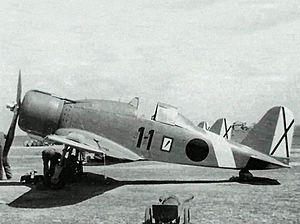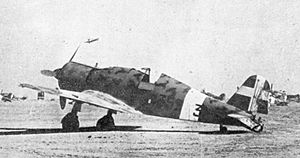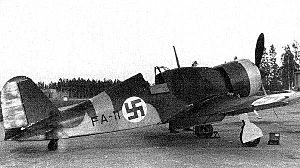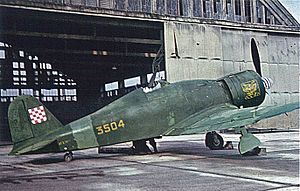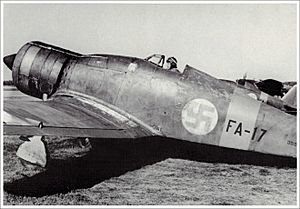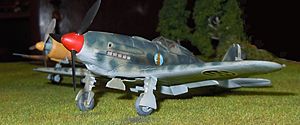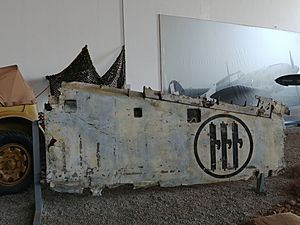Fiat G.50 Freccia facts for kids
Quick facts for kids G.50 Freccia |
|
|---|---|
 |
|
| A Regia Aeronautica G.50 flying with a Luftwaffe Messerschmitt Bf 110 over North Africa in 1941 | |
| Role | Fighter aircraft |
| Manufacturer | Fiat |
| Designer | Giuseppe Gabrielli |
| First flight | 26 February 1937 |
| Introduction | 1938 |
| Retired | 1946 Finnish Air Force |
| Status | Retired |
| Primary users | Regia Aeronautica Finnish Air Force Ejército del Aire Luftwaffe |
| Produced | 1935–1943 |
| Number built | 683 + 5 prototypes |
| Variants | Fiat G.55 |
The Fiat G.50 Freccia (which means "Arrow") was an Italian fighter aircraft from World War II. It was built by the company Fiat. When it first flew, it was Italy's first fighter plane that had only one seat, was made entirely of metal, had an enclosed cockpit, and had landing gear that could be pulled up into the plane.
The G.50 first flew on February 26, 1937. In early 1938, these "Arrows" joined the Regia Aeronautica (the Italian Air Force). They also flew with the Aviazione Legionaria in Spain during the Spanish Civil War. There, they were good at speed and could turn well against enemy planes.
Italy used the G.50 a lot in different places, like Northern Europe, North Africa, the Balkans, and itself. The G.50 often fought against the British Hawker Hurricane. The Hurricane was usually faster and could fly further than the G.50. Also, early in World War II, it became clear that the G.50 did not have enough weapons. It only had two Breda-SAFAT 12.7-mm machine guns. Later versions of the plane were improved, including holding more fuel, which made them able to fly much further.
The G.50 was also sold to other countries. A few were used by the Croatian Air Force. Finland bought 35 G.50 fighters. These planes did very well in Finland during the Winter War (1939–1940) and the Continuation War (1941–1944) against the Soviet Union. In Finland, the G.50 was said to have shot down 33 enemy planes for every one lost, which is a very high ratio!
Contents
How Was the G.50 Developed?
Starting the Design
The Fiat G.50 was designed by an Italian engineer named Giuseppe Gabrielli. This was a big change for Fiat, as they usually relied on another engineer, Celestino Rosatelli. The design was also influenced by a request in 1936 for a new interceptor aircraft for the Regia Aeronautica (Italian Air Force).
Gabrielli began working on the design in April 1935. It was a very modern design for its time. When it was introduced, it became the most advanced fighter plane built in Italy. Building of two test planes started in mid-1936. Another Fiat company, CMASA, built them in Marina di Pisa.
The first test plane flew for the first time on February 26, 1937. Comandante Giovanni de Briganti, the main test pilot, flew it from Caselle airfield in Turin. During this flight, the plane reached a top speed of 472 km/h (293 mph). It also climbed to 6,000 meters (19,685 ft) in just 6 minutes and 40 seconds. It was shown to the public in October 1937 at an air show in Milan.
Because it was a new design, they decided to do many test flights to check its performance. An experimental group was formed in 1937. Early flights showed that the G.50 was easy to control and very good at turning for a monoplane (a plane with one set of wings). However, two problems were found: its radial engine was not powerful enough, and it only had two machine guns, which was not enough firepower.
First Orders and Tests
In September 1937, Fiat received an order for 45 more G.50 planes. Before placing a bigger order, the Italian Air Ministry decided to test the G.50 against the new Macchi MC.200. On November 8, 1937, test pilot de Briganti died during a flight when the second test plane (M.M.335) crashed after a high-speed dive. Tests showed that the plane could easily go into an uncontrolled spin, which was very dangerous, especially close to the ground.
Another accident happened during a visit by the Italian King Victor Emmanuel III and Prime Minister Benito Mussolini. Three G.50s, flown by experienced pilots, had trouble during a low, fast pass. One plane spun out of control and crashed, killing the pilot. Despite these crashes, the tests were mostly good. The Freccia was more maneuverable than the faster Macchi MC.200. So, on June 9, 1938, the G.50 was chosen as the winner of the "Fighter One" competition. The Regia Aeronautica also ordered the G.50 because it was so easy to maneuver.
The first production planes were given to the Regia Aeronautica in early 1939. Italian pilots reportedly did not like the enclosed cockpit. It was hard to open quickly, and the plastic glass was often poor quality. It could crack or get scratched by sand, making it hard to see. Also, exhaust fumes would build up inside. So, pilots often flew with the cockpit open. Because of this, the next 200 planes were built with an open cockpit.
After 1939, most G.50s were built at the CMASA factory in Marina di Pisa. Early G.50s could have different weapons: one or two 12.7-mm (.5 in) Breda-SAFAT machine guns in the nose. Some also had two 7.7-mm (.303 in) Breda-SAFAT guns in the wings. Later versions of the plane had a larger rudder (the part that helps steer the plane's tail).
More Improvements
In 1938, the Regia Aeronautica asked for a two-seat training version of the G.50, called the G.50/B (meaning "dual control"). The first of these were built in late 1939. The student pilot sat in the front. CMASA built 106 G.50/Bs. One G.50/B was later changed into a plane for taking pictures from the air. Another was fitted with a tailhook to operate from an aircraft carrier, but that ship was never finished.
In September 1940, an improved version, the G.50 bis, was introduced. Its main advantage was a longer flight range. An extra fuel tank increased its range from 645 km (401 miles) to 1,000 km (621 miles).
The very last version was the G.50/V (meaning "Fast"), built in mid-1941. It had a more powerful Daimler-Benz DB 601 engine. During tests, it reached a top speed of 570 km/h (354 mph) and climbed to 6,000 meters (19,685 ft) in 5 minutes and 30 seconds. However, by this time, Fiat was already designing the Fiat G.55, which was even better. So, the G.50/V was used for testing new equipment and then taken apart.
In total, 784 G.50 aircraft were built. Fiat Aviazione made 426, and CMASA built 358. Fifty-eight planes were sold to other countries: 13 to Spain, 35 to Finland, and 10 to Croatia.
Two G.50s meant for Finland were destroyed before they arrived because they ran out of fuel. On March 7, a pilot forgot to switch the fuel pump to the main tank, and his G.50 (FA-8) crashed, injuring him. On March 8, a Hungarian volunteer pilot crashed into the Baltic Sea, likely after running out of fuel while trying to fly from Sweden to Finland. His plane (FA-7) and he were never found.
How the G.50 Was Designed
The Fiat G.50 was a fighter plane with one engine and low wings. It was made entirely of metal. The body was made of light metal alloys. The wings had three parts, with a strong steel center and lighter metal outer wings. The parts that help the plane turn (ailerons) were covered in fabric. The plane also had special flaps that helped it take off and land better. These flaps would automatically pull back when the plane reached a certain speed.
The G.50 had landing gear that could be pulled up into the plane. It was the first Italian fighter to have this feature, along with an enclosed cockpit and a propeller that could change its speed. These improvements made the G.50 33 km/h (21 mph) faster than the Fiat CR.42 biplane, which was a plane with two sets of wings. Aviation writer Gianni Cattaneo said the G.50 was a "strong and reliable aircraft."
The plane was powered by a single Fiat A.74 R.C.38 engine. This was a 14-cylinder, air-cooled engine. It produced 870 horsepower for take-off and 960 horsepower at 3,800 meters (12,467 ft). The engine was covered by a special NACA cowling that helped with airflow. Large doors on the cowling allowed for easy maintenance. The engine turned a 3-bladed metal propeller.
The pilot sat in an enclosed cockpit with a clear sliding cover. The seat could be adjusted for height and angle. Even though the canopy was clear, pilots did not like it. They found it hard to open quickly, and it would get scratched easily. Also, exhaust fumes would build up. So, pilots often flew with the canopy open. Later, hinged clear side-flaps were added.
The plane had a special sight to help aim its weapons. It had two 12.7 mm (.5 in) Breda-SAFAT machine guns, each with 300 rounds of ammunition. The machine guns were in front of the cockpit and fired through the propeller using a special device. Pilots could fire single shots or bursts.
Where the G.50 Was Used
First Flights and Early War
The first Fiat G.50 fighters were given to the Regia Aeronautica in 1938. About a dozen G.50s were sent to Spain to help the Aviazione Legionaria during the Spanish Civil War. The first ones arrived in January 1939. However, these planes did not see much actual fighting in Spain. After the war, the G.50s were given to Spanish pilots and later flew in Morocco. One expert said that "Little seems to have been learnt as nothing was done to increase the armament."
When the G.50 first entered service, it was seen as a very easy-to-maneuver plane and one of Italy's best fighters. But by the start of World War II, aviation technology had moved very fast. The G.50 was then seen as not powerful enough and not armed enough compared to other top fighter planes. Still, before World War II, more Italian Air Force units received G.50s. They were used a lot in training exercises from November 1939 as it became clear Italy would soon join the war.
When Italy entered World War II in June 1940, the Regia Aeronautica had 118 G.50s ready for action. Most were with the 51° Stormo (group) near Rome and at Pontedera. On June 10, 1940, when Italy declared war on France and Great Britain, the G.50s of the 22° Gruppo (wing) went into action. They often flew as escorts for Savoia-Marchetti SM.79 bombers attacking harbors and airfields on the island of Corsica. These missions quickly ended when France surrendered.
Fighting in Belgium and the Battle of Britain
In September 1940, a group of G.50s was sent to Belgium to take part in the Battle of Britain. This was part of the Corpo Aereo Italiano (Italian Air Corps, CAI). The G.50 was not very good for this fight because it was slow, had open cockpits (which were cold in northern Europe), and could not fly very far. Bad weather and unprepared crews also made it harder for them to be effective. The early G.50s sent there had open cockpits, which were fine in the warm Mediterranean but made pilots suffer in the cold. The planes also had poor radios and no armor to protect the pilot.
The G.50s quickly showed their weaknesses in combat over Britain. Their missions were almost useless because they could not fly far enough and were based too far from enemy territory. G.50 missions rarely lasted more than an hour. A newer version, the G.50 bis, with larger fuel tanks, was being built but did not arrive in time. Their performance was also poor. For example, on November 5, 1940, 22 G.50s tried to catch some British Hawker Hurricanes, but the Hurricanes easily got away. On November 21, 1940, two G.50s tried to catch a Bristol Blenheim bomber but lost it in the clouds.
In early 1941, the Italian Air Corps went back to Italy. Two G.50 squadrons stayed in Belgium until April 1941. Overall, the G.50s flew 429 missions but did not fight any enemy planes. One plane was lost, and seven were damaged. While with the German air force, four more G.50s were lost, and two pilots died. Some G.50s were even damaged by friendly fire from German planes.
In Belgium, the Italian pilots saw the German Messerschmitt Bf 109 in action. Some G.50 pilots even learned to fly the Bf 109.
The North African Campaign
On December 27, 1940, the first 27 G.50s arrived in Libya, North Africa. On January 9, 1941, they flew their first combat mission there. One G.50 pilot was attacked by a Hawker Hurricane and had to crash-land. Another G.50 unit arrived in Libya on January 31, 1941. However, because the Italian Army was retreating, the G.50s did not see much action at first.
One of the first times a Freccia pilot claimed to shoot down an enemy plane was on April 9, 1941. A pilot attacked three British Hurricane Mk Is and claimed to have shot one down, though this was not confirmed. He had to crash-land his own G.50 but was not hurt.
Low-level air fights were often confusing. Being able to surprise the enemy was key. On April 14, 66 Axis planes, including eight G.50s, attacked British forces near Tobruk. The British Hurricanes were outnumbered. They had to ignore the Axis fighters and focus on attacking the bombers, which were a bigger threat. Two G.50 pilots attacked a Hurricane that was shooting at a Stuka dive bomber. The Hurricane was shot down, and its pilot was killed. Then, a Canadian pilot shot down both G.50 pilots and damaged another G.50 before he was shot down himself.
On May 27, a new unit with the improved Fiat G.50 bis arrived. This new version could fly for almost two hours because it had an extra fuel tank. The G.50s usually flew at lower altitudes over North Africa, not going higher than 4,500 meters (14,764 ft). The planes still lacked radios, and the desert sand could wear out the engine quickly.
Even though G.50s were often outmatched by other fighters, skilled pilots sometimes managed to shoot down faster and better-armed Hurricanes and P-40s. For example, on July 9, 1941, a G.50 pilot shot down two British Blenheim bombers and two more went missing. For this, he received a medal.
During the Battle of Sidi Barrani, G.50s attacked the British airfield at Sidi Barrani. On November 18, 1941, during Operation Crusader, British planes destroyed 13 aircraft at the Ain el Gazala airfields, 10 of which were G.50s. On November 19, a G.50 unit suffered heavy losses when British ground forces suddenly attacked their airfield. Out of 19 G.50s, only three escaped. Many pilots and ground crew were captured. Several G.50s were captured almost undamaged by the British.
After 1941, the G.50 played a smaller role in the Italian Air Force. By June 1942, British intelligence estimated that only 10 G.50s were ready for service.
Fighting in the Aegean Sea
After Italy declared war on Greece in October 1940, the Freccia planes started attacking Greek and Allied forces over the Balkans and the Aegean Sea. They usually flew from airfields in Albania and Italy.
During the Greek campaign, bad weather often made air operations difficult. However, there were some fierce air battles. On February 20, 1941, British Hawker Hurricanes fought their first air battle over the Balkans. Seven G.50s were sent to stop British bombers and their Hurricane escorts. The Freccias claimed to have shot down a bomber and a fighter, while the British claimed four G.50s. Later that day, 15 G.50s fought a large group of British Gloster Gladiators. The Italians claimed 10 planes shot down for the loss of one G.50. The British claimed three G.50s with no losses. Records after the war showed one British bomber and one G.50 were lost that day.
On February 28, 1941, British planes attacked Italian bombers and their escorts. The British claimed to have shot down 27 planes. The Italians claimed six Gladiators and one Supermarine Spitfire. The actual losses were one Gladiator and eight Italian planes. After this battle, the Regia Aeronautica was not as strong in that area.
On March 4, 1941, a single G.50 bis shot down a Hurricane piloted by a famous Australian RAF pilot, Nigel Cullen, who had many victories. During the Greek campaign, 10 G.50 fighters were lost due to combat, accidents, and Allied bombing of Italian airfields.
Fighting in Sicily and Italy
In the second half of the war, the G.50 was often used as a multi-purpose fighter and ground attack plane, carrying bombs. During the start of the Allied invasion of Sicily, the G.50 was the most common Italian plane used to fight back against the Allied landings.
Before the invasion, a special ground attack unit of the Italian Air Force, with G.50 bis fighter-bombers, moved to Southern Italy. When the invasion started on July 10, 1943, more units were sent to help. Forty-five G.50 bis planes were sent to attack Allied ships, landing craft, and troops. On July 11, 10 G.50s were intercepted by many Allied fighters. Three G.50s were shot down, including the commander of the unit. The remaining Italian planes returned to their base, where most were destroyed on the ground by another air attack.
By the time of the Italian surrender to the Allies, only a few G.50 fighters were left in Italy. Some continued to fly with the Italian Co-Belligerent Air Force, which fought with the Allies. At least four G.50s were used by the Aeronautica Nazionale Repubblicana (a pro-German Italian air force) as trainer planes. The top Italian pilot to use the G.50 was Furio Lauri, who had 11 "kills" by the end of 1941 and eventually shot down 18 enemy planes.
The G.50 in Finland
The G.50 had its longest and most successful service in Finland's two wars against the Soviet Union: the Winter War (1939–1940) and the Continuation War (1941–1944). In late 1939, Finland ordered 35 Fiat G.50s. The first 10 were supposed to arrive before February 1940. Finnish pilots went to Italy for a 10-hour training course. During one training flight, a pilot reached a very high speed, which damaged the plane's windshield.
Germany made it difficult to transport the planes. So, they were taken apart and shipped to Finland. Because of this delay, the first G.50s did not reach the Finnish Air Force's No. 26 Squadron, Finnish Air Force (HLeLv 26) until February 1940. The G.50s were numbered from FA-1 to FA-35, but it seems only 33 were delivered.
Two G.50s were destroyed in accidents before they could be used in combat. One crashed because the pilot forgot to turn on the main fuel pump. Another crashed into the Baltic Sea, likely after running out of fuel.
The Italian fighters arrived too late to greatly affect the Winter War. However, most were soon sent to the front. Fiat pilots fought heavily over the bay of Vyborg in late February and early March. The first kill was reportedly on February 26. The next day, a Finnish pilot became the first to die in a G.50 when his plane crashed after a battle. On March 11, an Italian volunteer pilot died in a crash while returning from a mission. The Fiat bases were often attacked. The Utti airfield was bombed, so the planes were moved to a nearby frozen lake. Later, another lake-side base was set up near Lahti.
Overall, HLeLv 26 achieved 11 kills during the Winter War, with one combat loss and one pilot killed in an accident (the plane was repaired).
The Finnish G.50s were mostly from the "Serie II" version, which had an open cockpit. Finnish pilots did not like this, especially in winter. There were attempts to improve the planes, like adding an enclosed cockpit or skis for landing on snow, but these changes were not widely used. The speed of the Finnish G.50s was lower than standard, around 430–450 km/h (267–280 mph). At this time, Finnish pilots preferred other planes like the Hawker Hurricane and Brewster F2A Buffalo over the G.50.
Air Victories in Early 1940
| Fiat G.50 | FA-4 | FA-5 | FA-9 | FA-13 | FA-20 | FA-21 | Aaltonen | Linnamaa | Nieminen | Paronen | Puhakka | |
|---|---|---|---|---|---|---|---|---|---|---|---|---|
| 26-02-1940 | I-16, I-152 | DB-3 | DB-3 |
|
||||||||
| 28-02-1940 | DB-3 | DB-3 | SB, SB | DB-3 | SB, SB | DB-3 | ||||||
| 02-03-1940 | I-153 | I-153 | ||||||||||
| 09-03-1940 | I-153 |
|
||||||||||
| 11-03-1940 | DB-3 |
The Finnish Air Force showed how effective it was on June 25, 1941. G.50s from HLeLv 26 shot down 13 out of 15 Soviet SB bombers.
During the Continuation War, the G.50s were most successful in 1941. After that, they became less effective. In 1941, HLeLv 26 claimed 52 victories for the loss of only two fighters. The Soviets brought newer and better fighters to the front in 1942 and 1943. The Fiats were getting old and worn out, and there were not enough spare parts. Still, between November 30, 1939, and September 4, 1944, the G.50s of HLeLv 26 shot down 99 enemy aircraft, even more modern ones. In the same time, Finnish squadrons lost 41 planes of different types. But only three Fiat G.50s were lost in combat, giving them a victory-to-loss ratio of 33 to 1.
The most successful Finnish G.50 pilots included Oiva Tuominen (23 victories) and Olli Puhakka (11 or 13 victories). The Finnish G.50s were finally taken out of front-line duty in the summer of 1944. There were only about 10 to 12 left, and they did not last long even as trainers because of the lack of spare parts. The last G.50 was removed from service on December 13, 1946.
The G.50 in Croatia
In October 1941, the Croatian Air Force Legion asked Italy for military help. Italy agreed to send 10 Fiat G.50s (nine single-seaters and one two-seater). On June 12, 1942, the Fiat G.50 bis fighters took off for Croatia. But they were stopped by the Italian Supreme Command, who worried that the Croatian pilots might switch sides. The G.50s had to wait until June 25 before being delivered to the Croatian Air Force. They were used a lot until 1945 against Yugoslav Partisans (resistance fighters). In 1942, a Croatian G.50 bis squadron was even sent to the Ukrainian front.
On June 25, 1943, the Croatian Air Force received nine G.50 bis fighters and one G.50B. They flew many missions attacking partisans for nearly a year.
After Italy surrendered on September 8, 1943, the German Air Force (Luftwaffe) gave the Croatian Air Force 20–25 Fiat G.50s that they had captured from Italian airfields. These planes were used by two Croatian fighter units, but by the end of 1943, only 10 planes remained. In 1944, some G.50s were used at a training school. In 1945, the Croatian Air Force had seven G.50s, with two ready to fly. On March 10, 1945, six of these Fiats were based at Lucko. On March 25, three were damaged by British RAF planes attacking the airfield. The next day, one of the last working Freccia planes was flown to a British airfield by a Croatian pilot who switched sides. The last G.50s were captured by Yugoslav Partisans. After the war, the G.50s were used for some time by the new Yugoslav Air Force. These were the last G.50s in active service.
Different Versions of the G.50
- G.50: This was the first version made.
- G.50 bis: An improved version of the G.50 with a longer flight range. 421 were built.
- G.50 bis/A: A two-seat carrier fighter, only one was changed from a G.50B.
- G.50 ter: A more powerful version with a 746 kW (1,000 hp) Fiat A.76 engine. Only one was built.
- G.50V: A version with a liquid-cooled Daimler-Benz DB 601 engine. Only one was built.
- G.50 bis A/N: A two-seat fighter-bomber test plane. Only one was built.
- G.50B: A two-seat trainer version. 100 aircraft were built.
- G.51: A planned production version of the G.50V, but they decided to build the Fiat G.55 instead.
- G.52: A planned version of the G.50 with a different engine, but the engine was never made, so the G.52 was never built.
Who Used the G.50?
 Croatia
Croatia
- Air Force of the Independent State of Croatia received more than 15 planes.
 Finland
Finland
- Finnish Air Force received 33 planes out of 35 ordered. Two were destroyed in accidents before arriving.
- No. 26 Squadron, Finnish Air Force
- Finnish Air Force received 33 planes out of 35 ordered. Two were destroyed in accidents before arriving.
 Germany
Germany
- Luftwaffe (German Air Force)
 Kingdom of Italy
Kingdom of Italy
- Regia Aeronautica (Italian Air Force)
- Gruppo Sperimentale da Caccia (Experimental Fighter Group)
- Many squadrons (351st, 352nd, 353rd, 354th, 355th, 357th, 358th, 359th, 360th, 361st)
- Aviazione Legionaria (Italian volunteer air force in Spain)
- Italian Co-Belligerent Air Force (fought with the Allies after 1943)
- Regia Aeronautica (Italian Air Force)
 Italian Social Republic
Italian Social Republic
- Aeronautica Nazionale Repubblicana (pro-German Italian air force after 1943)
 Spain
Spain
- Ejército del Aire
 Yugoslavia
Yugoslavia
- SFR Yugoslav Air Force (used one captured from Croatia)
Surviving G.50 Planes
As of September 2010, the only known G.50 bis still existing was being fixed up at the Museum of Aviation in Surčin, Serbia.
G.50 Specifications (Details)
Data from A Second String Arrow...The Fiat G.50
General characteristics
- Crew: 1 pilot
- Length: 8.01 m ([convert: unknown unit])*
- Wingspan: 10.99 m ([convert: unknown unit])*
- Height: 3.28 m ([convert: unknown unit])*
- Wing area: 18.25 square[convert: unknown unit]
- Empty weight: 1,963 kg ([convert: unknown unit])*
- Max takeoff weight: 2,402 kg ([convert: unknown unit])*
- Powerplant: 1 × Fiat A.74 R.C.38 14-cylinder air-cooled radial engine, 649 kW ([convert: unknown unit])*
- Propellers: 3-bladed Hamilton Standard-Fiat constant-speed propeller
Performance
- Maximum speed: 470 km/h ([convert: unknown unit])*
- Range: 445 km ([convert: unknown unit])*
- Service ceiling: 10,700 m ([convert: unknown unit])*
- Time to altitude: 5,000 meters (16,404 ft) in 6 minutes 3 seconds
Armament
- Guns: 2 × 12.7 mm (0.50 in) Breda-SAFAT machine guns
More About the G.50
 In Spanish: Fiat G.50 para niños
In Spanish: Fiat G.50 para niños
- Aircraft related to this one
- Fiat G.55
- Similar aircraft
- Bloch MB.150
- Curtiss P-36 Hawk
- IAR 80
- Koolhoven F.K.58
- Macchi C.200
- Nakajima Ki-43
- Polikarpov I-16
- Reggiane Re.2000
- Seversky P-35
- Weiss Manfréd WM-23 Ezüst Nyíl
- Lists related to this aircraft
- List of aircraft of World War II
- List of aircraft of Italy in World War II


